FRIDAY, OCTOBER 28
■ This is the time of year when the Big Dipper lies down horizontal low in the north-northwest after dark. How low? The farther south you are, the lower. Seen from 40° north (New York, Denver) even its bottom stars twinkle nearly ten degrees high. But at the latitude of Miami (26° N) the entire Dipper skims along just below the northern horizon out of sight.
SATURDAY, OCTOBER 29
■ The waxing crescent Moon is back in the evening sky, low in the southwest. As twilight deepens and the stars come out — but before the Moon gets too low — look for the Sagittarius Teapot in its background as shown below. Binoculars help.
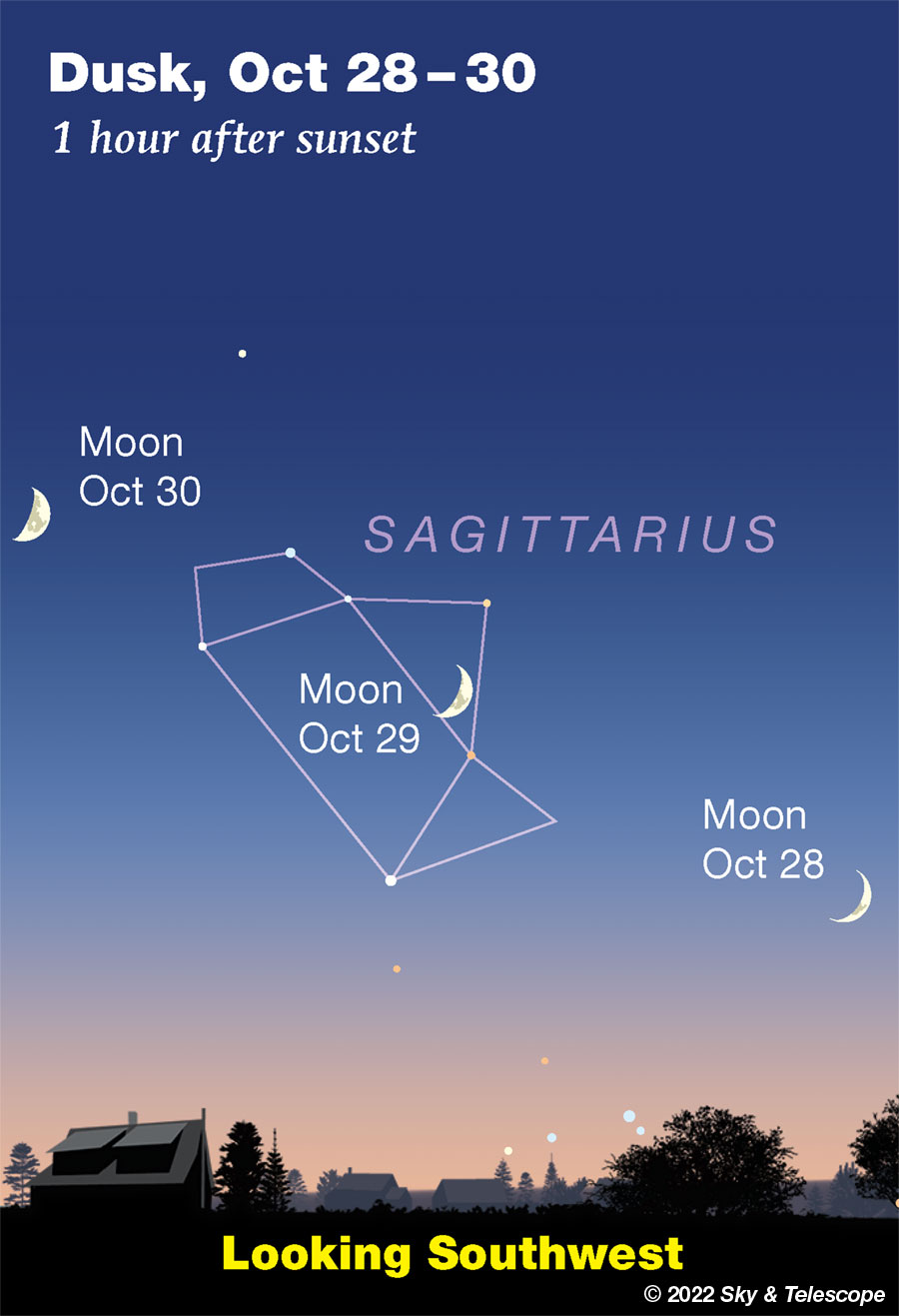
You'll need a good sense of the size of your binoculars' field of view. A typical binocular's field is a little larger than the Teapot's handle.
These scenes are always drawn for an observer at 40° north latitude, 90° west longitude, near the middle of North America. Elsewhere on the continent, the Moon will appear a bit differently placed with respect to the background stars.
■ After dark, spot the W of Cassiopeia high in the northeast. It's standing on end (its fainter end).
The third segment of the W, counting down from the top, points down. Extend that segment twice as far down as its own length, and you're at the Double Cluster in Perseus. In a dark sky, this pair of star-swarms is dimly apparent to the unaided eye as an enhanced patch of Milky Way (use averted vision). With binoculars it's visible from almost anywhere. In a telescope, it's two overlapping cities of stars.
■ Jupiter's Great Red Spot should cross the planet's central meridian around 10:57 p.m. EDT; 7:57 p.m. PDT. The Red Spot, like all features on Jupiter, appears closer to the Jupiter's central meridian than its limb for 50 minutes before and it transits.
SUNDAY, OCTOBER 30
■ Jupiter lights the southeast after dark. Look below it by almost two fists for a 2nd-magnitude orange point. This is Diphda (Beta Ceti), the Frog Star. That's what the name means in Arabic. Almost halfway between them is fainter Iota Ceti, magnitude 3.5.
Look two or three fists right of Diphda and there's 1st-magnitude Fomalhaut, the Mouth of the Fish, the Alpha star of the Southern Fish, Piscis Austrinus. Jupiter and these stars form a big right triangle.
■ Algol should be at its minimum light, magnitude 3.4 instead of its usual 2.1, for a couple hours around 9:42 p.m. EDT (6:42 p.m. PDT). Algol takes several more hours to rebrighten.
MONDAY, OCTOBER 31
■ The Halloween Moon this year is first quarter (exactly first quarter at 2:37 a.m. EDT tonight). It hangs in the south in early evening, with distant Saturn glowing steadily to its upper left. Much farther left of Saturn is brighter Jupiter.
As night deepens, the dim boat-shaped pattern of Capricornus emerges shyly behind Saturn and the Moon.
TUESDAY, NOVEMBER 1
■ Now the Moon hangs much closer below Saturn. Look well to the Moon's lower left for Fomalhaut.
■ Jupiter's Red Spot transits the planet's central meridian around 8:32 p.m. EDT.
WEDNESDAY, NOVEMBER 2
■ Vega is the brightest star very high toward the west these evenings. Face west and look way up. Located 25 light-years away, Vega is a fast-rotating A star, larger and hotter than the Sun, that we happen to see almost pole-on.
■ Double shadow on Jupiter. This evening the little black shadows of Ganymede, Jupiter's largest moon, and Europa, the smallest of Jupiter's major moons, will both be cast onto the face of the planet from 8:22 to 9:00 p.m. EDT. Compare them. You'll recognize why some shadow transits on Jupiter are harder to spot than others!
THURSDAY, NOVEMBER 3
■ The Summer Triangle Effect. Here it is early November, but Deneb still shines near the zenith as the stars come out. And brighter Vega is still not far west of the zenith. The third star of the "Summer" Triangle, Altair, remains very high in the southwest. They seem to have stayed there for a couple of months! Why have they stalled out?
What you're seeing is the result of sunset and darkness coming earlier and earlier during autumn. Which means that if you go out and starwatch soon after dark, you're doing it earlier and earlier by the clock. This earlier viewing time counteracts the seasonal westward turning of the constellations.
Of course this "Summer Triangle effect" applies to the entire celestial sphere, not just the Summer Triangle. But the apparent stalling of that bright landmark in the fall inspired Sky & Telescope to give the effect that name many years ago, and it stuck.
Of course, as always in celestial mechanics, a deficit somewhere gets made up elsewhere. The opposite effect makes the seasonal advance of the constellations seem to speed up in early spring. The spring-sky landmarks of Virgo and Corvus seem to dash away westward from week to week almost before you know it, due to darkness falling later and later. Let's call this the "Corvus effect."
FRIDAY, NOVEMBER 4
■ The waxing gibbous Moon shines with Jupiter this evening, as shown below. They're only about 2° to 4° apart at the times of evening in the Americas.
They're both prime targets for small telescopes! Most scopes will usually show at least the tan North and South Equatorial Belts on Jupiter's dazzling whiteness, and of course its own four big moons on either side of it (except when one of them is hidden behind Jupiter, passing in front of it, or eclipsed in its shadow). Consider, as you look, that each of those four is roughly the size of our own Moon so much closer in the foreground.
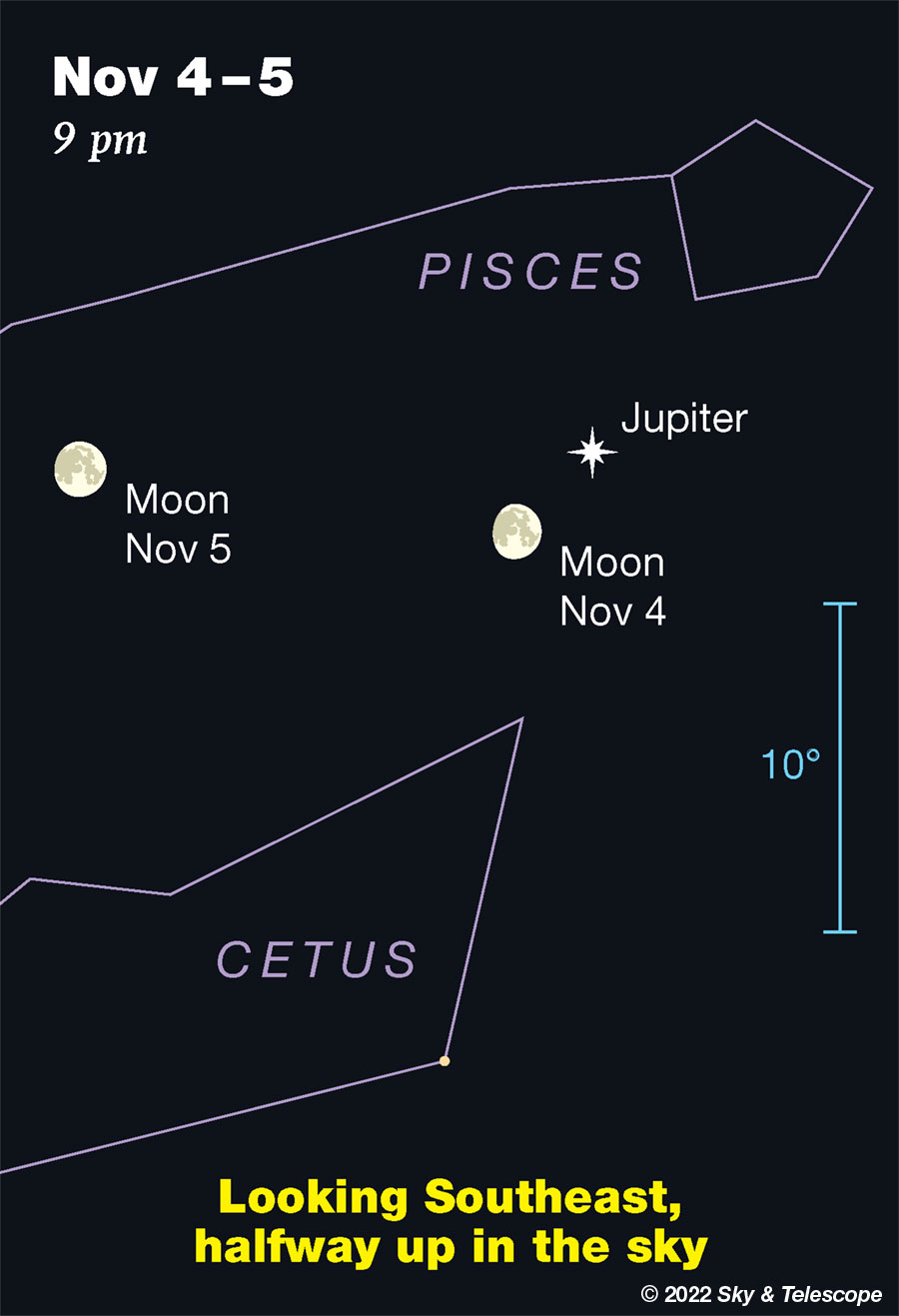
SATURDAY, NOVEMBER 5
■ Around 10 p.m., depending on where you live, zero-magnitude Capella rises exactly as high in the northeast as zero-magnitude Vega has sunk in the west-northwest. How accurately can you time this event? Sextant not required. . . but it would help.
■ Daylight-saving time ends at 2 a.m. Sunday morning for most of North America. Clocks fall back an hour to standard time.
■ Start planning for the total eclipse of the Moon that will happen next Tuesday, November 8th, before and/or during dawn for most of North and Central America. From Asia through Australia, the eclipse will be seen on the evening of the 8th local date. See the November Sky & Telescope, page 48.
This Week's Planet Roundup
Mercury and Venus are hidden in conjunction with the Sun.
Mars, magnitude –1.2 in eastern Taurus, clears the east-northeast horizon soon after dark and gains altitude for most of the night. There's no missing it when it's as bright as this! Mars lingers almost between the horntips of Taurus, Beta and Zeta Tauri; it's at the first stationary point of its retrograde (westward) loop against the background stars, on its way to opposition on the night of December 7-8.
Mars-colored Aldebaran, only a seventh as bright at magnitude +0.9, sparkles to Mars's upper right by 16°, about a fist and a half at arm's length. The same distance to the planet's lower right is Mars-colored Betelgeuse.
Once again, color perception in astronomy can be tricky. Read "Seeing the True Colors of Mars," a lesson for astronomers from a chemist, in the November Sky & Telescope, page 52.
In a telescope Mars is now 15 arcseconds wide, hardly less than its 17.2 arcseconds width around the time of its closest approach to Earth, December 1st.
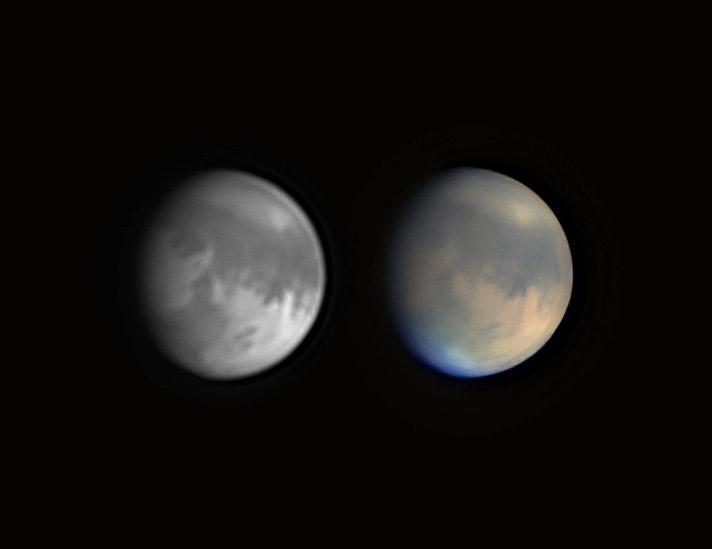
Dark areas near center with downward prongs are Margaritifer Sinus and Aurorae Sinus. Lower left of Margaritifer Sinus, dark Oxia Palus has grown large and joined with the Niliacus Lacus / Mare Acidalium complex below. Walker uses a Player One Astronomy Uranus-C video camera on a 12.5-inch Newtonian reflector.
Jupiter is more than a month past opposition. In early evening it blazes whitely high in the southeast at magnitude –2.8, in dim Pisces. It stands highest in the south around 10 p.m. daylight-saving time. In a telescope Jupiter is still a big 48 or 47 arcseconds wide.
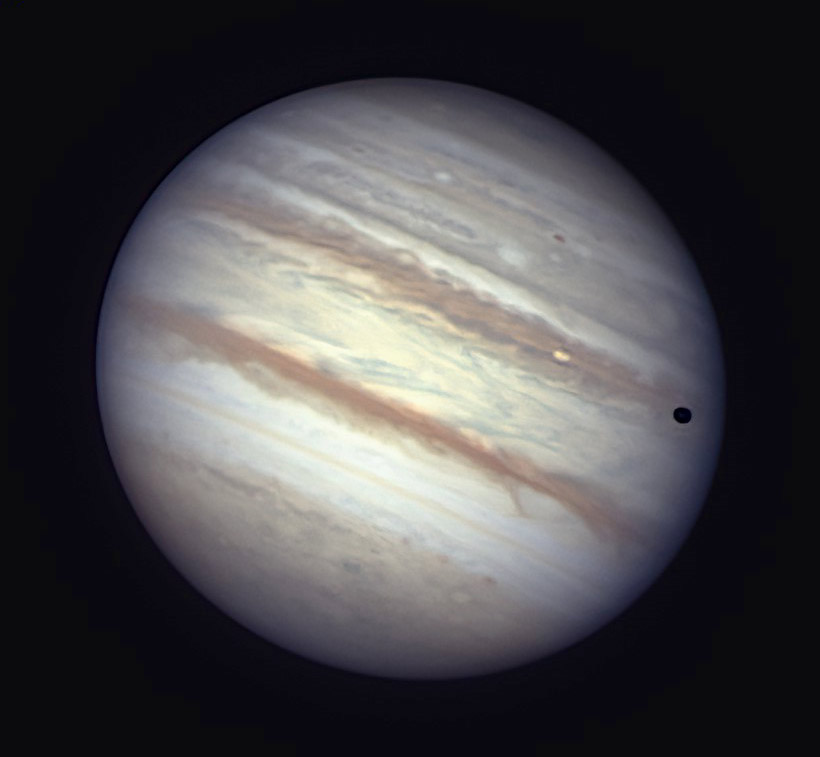
Walker imaged Jupiter on October 17th through excellent seeing. South is up. The dark dot is the shadow of Io, and Io itself is the little bright mark to the shadow's left. Of course Io is round; look carefully. Its darker polar regions blend in here with the dark South Equatorial Belt behind it. (Contrast in this image is enhanced.)
Saturn, magnitude +0.7 in Capricornus, glows highest in the south right after dark. As night progresses, it moves lower toward the southwest and sets around midnight or 1 a.m. daylight-saving time.
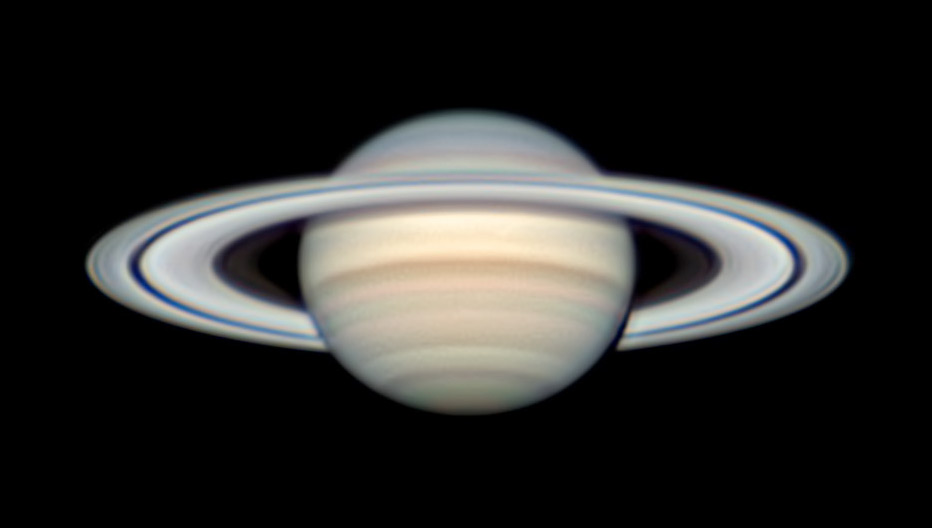
The gray band seen on the globe along the inner edge of the rings is not a belt or a shadow but the semi-transparent C ring.
Uranus, magnitude 5.6 in Aries and nearly at opposition, is up in the east in good binocular or telescope view by mid- to late evening. See the Uranus finder charts in the November Sky & Telescope, page 49.
Neptune, magnitude 7.8 at the Aquarius-Pisces border, is high in the evening about 7° west of Jupiter. See the Neptune finder charts in the September Sky & Telescope, page 49.
All descriptions that relate to your horizon — including the words up, down, right, and left — are written for the world's mid-northern latitudes. Descriptions and graphics that also depend on longitude (mainly Moon positions) are for North America.
Eastern Daylight Time, EDT, is Universal Time minus 4 hours. Eastern Standard Time, which begins Sunday morning November 6th, is UT minus 5 hours. (Universal Time is also called UT, UTC, GMT or Z time.)
Want to become a better astronomer? Learn your way around the constellations. They're the key to locating everything fainter and deeper to hunt with binoculars or a telescope.
This is an outdoor nature hobby. For an easy-to-use constellation guide covering the whole evening sky, use the big monthly map in the center of each issue of Sky & Telescope, the essential magazine of astronomy.
Once you get a telescope, to put it to good use you'll need a detailed, large-scale sky atlas (set of charts). The basic standard is the Pocket Sky Atlas (in either the original or Jumbo Edition), which shows stars to magnitude 7.6.

Next up is the larger and deeper Sky Atlas 2000.0, plotting stars to magnitude 8.5; nearly three times as many. The next up, once you know your way around, are the even larger Interstellarum atlas (stars to magnitude 9.5) or Uranometria 2000.0 (stars to magnitude 9.75). And be sure to read How to Use a Star Chart with a Telescope. It applies just as much to charts on your phone or tablet as to charts on paper.
You'll also want a good deep-sky guidebook. A beloved old classic is the three-volume Burnham's Celestial Handbook. An impressive more modern one is the big Night Sky Observer's Guide set (2+ volumes) by Kepple and Sanner.
Can a computerized telescope replace charts? Not for beginners, I don't think, and not on mounts and tripods that are less than top-quality mechanically, meaning heavy and expensive. And as Terence Dickinson and Alan Dyer say in their Backyard Astronomer's Guide, "A full appreciation of the universe cannot come without developing the skills to find things in the sky and understanding how the sky works. This knowledge comes only by spending time under the stars with star maps in hand."
![]() Audio sky tour. Out under the evening sky with your
Audio sky tour. Out under the evening sky with your
earbuds in place, listen to Kelly Beatty's monthly
podcast tour of the heavens above. It's free.
"The dangers of not thinking clearly are much greater now than ever before. It's not that there's something new in our way of thinking, it's that credulous and confused thinking can be much more lethal in ways it was never before."
— Carl Sagan, 1996
"Facts are stubborn things."
— John Adams, 1770
 3
3









Comments
Rod
October 30, 2022 at 7:43 am
Some very enjoyable Mars viewing last night. Observed 2230-2330 EDT. Waxing crescent Moon set 2127 EDT this evening in Sagittarius. Mars rises 2048 EDT in Taurus. Mars begins retrograde motion tonight. Starry Night Pro Plus 8 Sky Calendar – “October 29, 2022, Saturday Mars Enters Retrograde (overnight) VIEW On Saturday night, October 29 in the Americas, Mars’ eastward prograde motion through the stars of Taurus will slow to a stop in order for it to begin a westerly retrograde loop that will last through its December opposition and into mid-January. On Saturday evening, bright, reddish Mars will be positioned in the eastern sky between the two horn tips of the bull, the medium-bright stars Zeta Tauri and Elnath. Over the next month, you can watch Mars swing between those stars and then race west (red path with date:hr) towards the bright Pleiades star cluster.” I used my 90-mm refractor and viewed at 31x to 200x. Filters used #23A red filter, #58 Green filter, and #12 yellow filter. The Sky & Telescope tool, Mars Profiler showed Elysium and area near the central meridian. Some distinct dark areas visible below Elysium and lighter region in the southern area. December 7th, Mars at opposition and the Full Moon occults Mars in parts of the USA that night. Where I view, the Moon will be just a bit closer than 2 arcminute angular separation at 2246 EST. That could make some interesting views using telescopes with the Tycho crater area and Mars visible in the field of view near the lunar limb. Details in the December Sky & Telescope magazine on pages 48-49. Great Horn owls were out tonight calling. Clear skies and temperature 3C.
You must be logged in to post a comment.
Rod
November 1, 2022 at 9:25 pm
Another good night for viewing. Observed 1930-2030 EDT. First Quarter Moon 01-Nov-2022 0637 UT. When I viewed this evening, the Moon just past First Quarter and bright. I used my 90-mm refractor telescope with TeleVue 14-mm Delos for 71x, true FOV a bit more than 60 arcminutes. The Moon and Saturn tonight in Capricornus ~ 4.5-degrees apart. Easy observations. While observing the Moon, I used a Moon filter. Much crater detail and relief visible along the terminator line. Craters like Archimedes examined, Eudoxus and some others in the northern area of the Moon. In the south, Maginus showed good sunlight on the crater wall and rim along with many other craters visible in the southern limb along the terminator line. I used the Virtual Moon Atlas to identify various craters along or near the terminator line. Stellarium 1.1 showed the angular separation between the Moon and Saturn as well as Starry Night. Saturn was lovely at 71x. Titan distinct near 7:30 position, mirror reverse view. The Cassini division, hints visible along with some cloud bands in the northern area of Saturn, with tiny slice of shadow on the rings. Higher magnification shows more but the 71x view with a bit more than 1-degree true FOV was excellent.
You must be logged in to post a comment.
misha17
November 3, 2022 at 6:51 pm
1. Early last Sunday around 4:30am, I had my first Canopus sighting of the season. Overcast weather and sleepiness kept from seeing it earlier this month.
2. Last night (Wed Nov 2nd) I noticed that Mars was slightly to the right of a line passing from Rigel to Bellatrix then continuing north. It will be interesting to see Mars' motion against this marker as its retrograde motion increases in the next framework days.
You must be logged in to post a comment.
You must be logged in to post a comment.